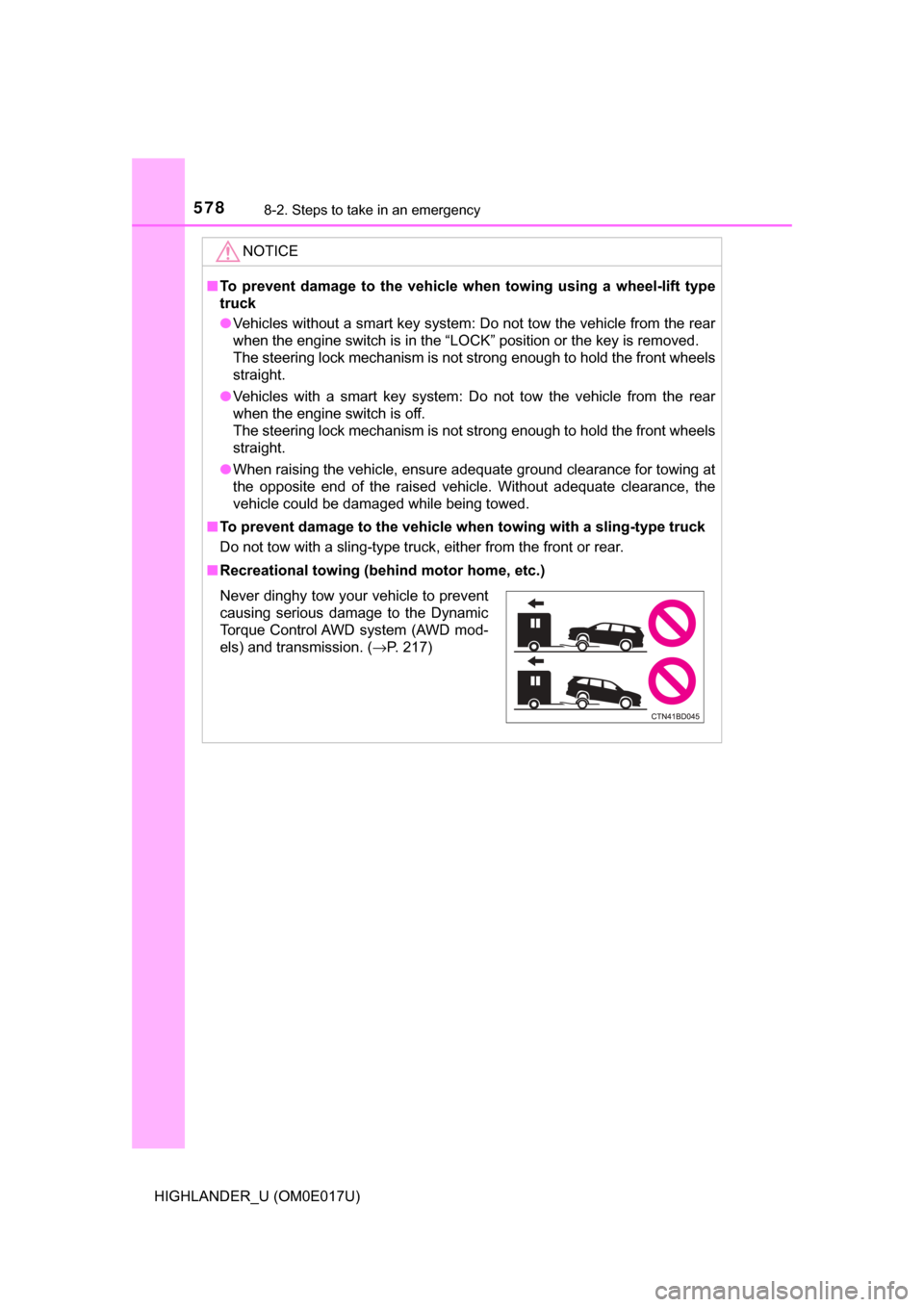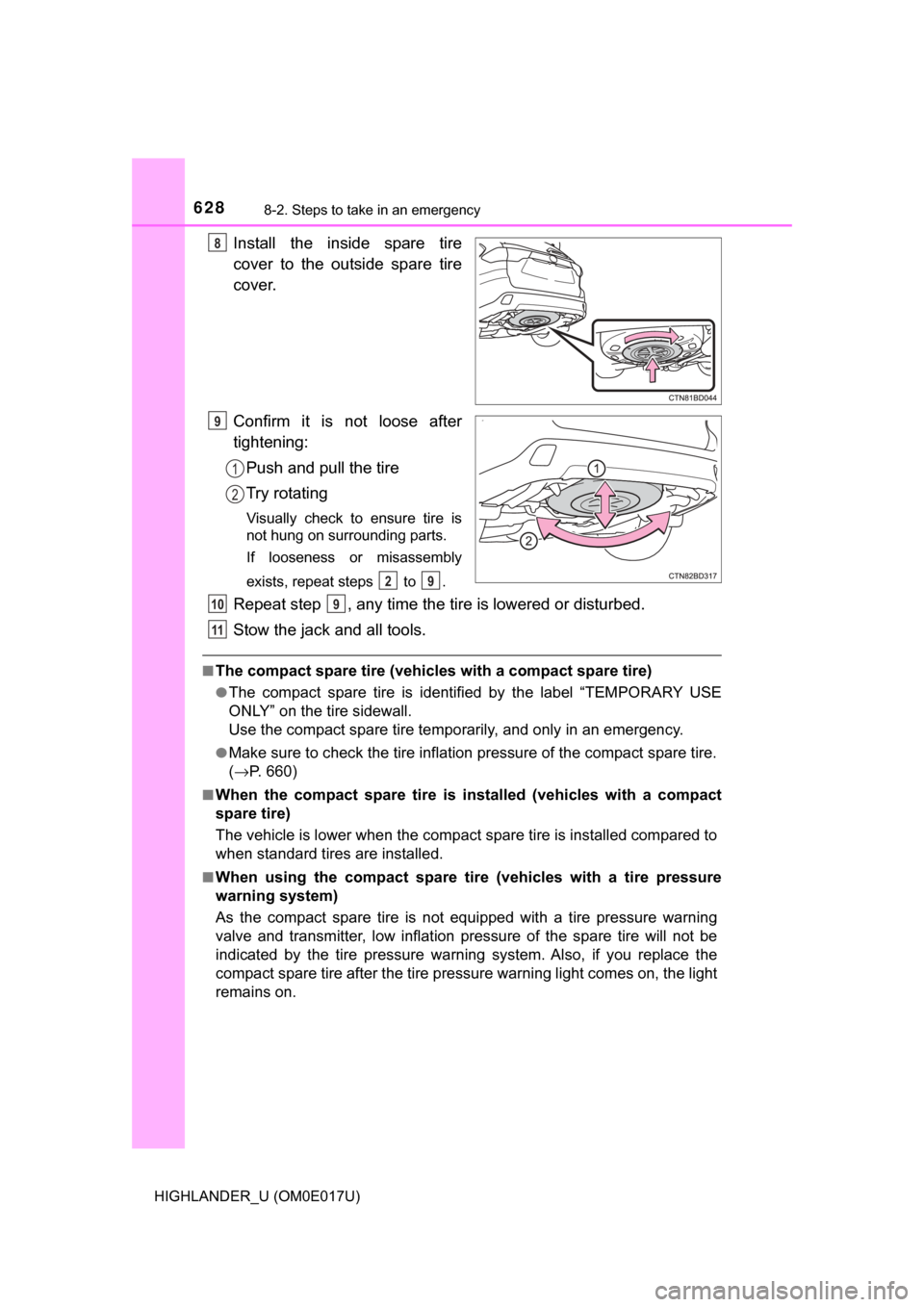Page 577 of 732
5778-2. Steps to take in an emergency
8
When trouble arises
HIGHLANDER_U (OM0E017U)
If you use chains or cables to tie
down your vehicle, the angles
shaded in black must be 45°.
Do not overly tighten the tie
downs or the vehicle may be dam-
aged.
WARNING
Observe the following precautions.
Failure to do so may result in death or serious injury.
■ When towing the vehicle
2WD models: Be sure to transport the
vehicle with the front wheels raised or
with all four wheels raised off the ground.
If the vehicle is towed with the front
wheels contacting the ground, the drive-
train and related parts may be damaged.
AWD models: Be sure to transport the
vehicle with all four wheels raised off the
ground. If the vehicle is towed with the
tires contacting the ground, the drivetrain
or related parts may be damaged, the
vehicle may fly off the truck.
Page 578 of 732

5788-2. Steps to take in an emergency
HIGHLANDER_U (OM0E017U)
NOTICE
■To prevent damage to the vehicle when towing using a wheel-lift type
truck
● Vehicles without a smart key system: Do not tow the vehicle from the rear
when the engine switch is in the “LOCK” position or the key is removed.
The steering lock mechanism is not strong enough to hold the front wheels
straight.
● Vehicles with a smart key system: Do not tow the vehicle from the rear
when the engine switch is off.
The steering lock mechanism is not strong enough to hold the front wheels
straight.
● When raising the vehicle, ensure adequate ground clearance for towing at
the opposite end of the raised vehicle. Without adequate clearance, the
vehicle could be damaged while being towed.
■ To prevent damage to the vehicle wh en towing with a sling-type truck
Do not tow with a sling-type truck, either from the front or rear.
■ Recreational towing (beh ind motor home, etc.)
Never dinghy tow your vehicle to prevent
causing serious damage to the Dynamic
Torque Control AWD system (AWD mod-
els) and transmission. (→P. 217)
Page 620 of 732
6208-2. Steps to take in an emergency
HIGHLANDER_U (OM0E017U)
■If the spare tire cannot be lowered
If the spare tire cannot be lowered, it may not have been stowed properly.
Perform the following procedure:
If the spare tire still cannot be lo wered, the wire cable may be severed.
Have the vehicle inspected by your Toyota dealer. Fully tighten the spare tire clamp bolt
by turning the jack handle clockwise
until two clicks are heard and the jack
handle skips.
Turn the jack handle counterclock-
wise to lower the spare tire.
If the spare tire
still cannot be low-
ered, attempt to fully tighten the spare
tire clamp bolt again by turning the
jack handle clockwise. Then turn it
counterclockwise at least 2 turns to
lower the spare tire.
1
2
Page 624 of 732
6248-2. Steps to take in an emergency
HIGHLANDER_U (OM0E017U)
Remove the center wheel ornament by pushing from the reverse
side.
Be careful not to lose the wheel ornament.
Stand the tire against the
bumper with the inner surface
facing toward you. Pass the
hoist assembly (C) and holding
bracket (B) through the wheel
opening.
Fully depress the secondary
latch (A) and install the bracket
(B) to the hoist assembly (C).
WARNING
■ Stowing the flat tire
Failure to follow steps listed under stowing the tire may result in dama\
ge to
the spare tire carrier and loss of the tire, which could result in serious injury
or death.
Stowing the flat tire, jack and all tools (with a compact spare tire)
1
2
3
Page 625 of 732
6258-2. Steps to take in an emergency
8
When trouble arises
HIGHLANDER_U (OM0E017U)
Lay the tire on the ground with
the outer surface (valve stem)
facing up.
Before raising the tire, make
sure that the hoist assembly is
perpendicular to the wheel
opening. (Try to place the tire
directly beneath the vehicle,
near where the wire cable is
hanging from.)
Using the jack handle and adapter socket, tighten the tire clamp
bolt by turning it clockwise until the tire is in the correct position and
two clicks are heard as the jack handle skips.
Confirm it is not loose after
tightening:Push and pull the tire
Try rotating
Visually check to ensure tire is
not hung on surrounding parts.
If looseness or misassembly
exists, repeat steps
to .
Repeat step , any time the ti re is lowered or disturbed.
Stow the jack and all tools.
4
Valve stem
5
6
7
1
2
27
87
9
Page 626 of 732
6268-2. Steps to take in an emergency
HIGHLANDER_U (OM0E017U)
Remove the center wheel ornament by pushing from the reverse
side.
Be careful not to lose the wheel ornament.
Stand the tire against the
bumper with the inner surface
facing toward you and install
the outside spare tire cover.
Pass the hoist assembly (C)
and holding bracket (B) through
the wheel opening.
WARNING
■ Stowing the flat tire
Failure to follow steps listed under stowing the tire may result in dama\
ge to
the spare tire carrier and loss of the tire, which could result in serious injury
or death.
Stowing the flat tire, jack and all tools (with a full-size spare tire)
1
2
3
Page 627 of 732
6278-2. Steps to take in an emergency
8
When trouble arises
HIGHLANDER_U (OM0E017U)
Fully depress the secondary
latch (A) and install the bracket
(B) to the hoist assembly (C).
Lay the tire on the ground with
the outer surface (valve stem)
facing up.
When stowing the tire, make
sure that the hoist assembly is
placed perpendicular to the
wheel opening.
Using the jack handle and adapter socket, tighten the spare tire
clamp bolt by turning it clockwise un til the tire is in the correct posi-
tion and two clicks are heard as the jack handle skips.4
5
Va l v e s t e m
6
7
Page 628 of 732

6288-2. Steps to take in an emergency
HIGHLANDER_U (OM0E017U)
Install the inside spare tire
cover to the outside spare tire
cover.
Confirm it is not loose after
tightening:Push and pull the tire
Try rotating
Visually check to ensure tire is
not hung on surrounding parts.
If looseness or misassembly
exists, repeat steps
to .
Repeat step , any time the ti re is lowered or disturbed.
Stow the jack and all tools.
■The compact spare tire (vehicles with a compact spare tire)
●The compact spare tire is identified by the label “TEMPORARY USE
ONLY” on the tire sidewall.
Use the compact spare tire temporarily, and only in an emergency.
●Make sure to check the tire inflation pressure of the compact spare tire.
( → P. 660)
■When the compact spare tire is installed (vehicles with a compact
spare tire)
The vehicle is lower when the compact spare tire is installed compared to
when standard tires are installed.
■When using the compact spare tire (vehicles with a tire pressure
warning system)
As the compact spare tire is not equipped with a tire pressure warning
valve and transmitter, low inflation pressure of the spare tire will not be
indicated by the tire pressure warning system. Also, if you replace the
compact spare tire after the tire pressure warning light comes on, the light
remains on.
8
9
1
2
29
109
11